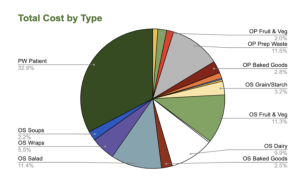
Pilot 5: Northern Light/Blue Hill Hospital
We partnered with Northern Light Health to conduct a two-month-long study to track, measure, and reduce food waste at their Blue Hill Hospital Facility. We worked closely with the Food Service Director and her team to conduct this study. The food waste study began on 11/7/2022 and was completed on 1/10/2023.
Goals
- To reduce food waste volume and costs.
- To gain the triple bottom line benefits of food waste reduction – save money, benefit people (customers, employees, and community) and to mitigate climate change.
Results
- Kitchen Waste represents the majority of food waste costs (67.1%).
- Outdated and Spoiled Food (vs. Over Production) was the largest category of Kitchen Waste at 41% of all food waste weight and 45.2% of food waste costs.
- Composting service was put in place to recycle any inedible food waste.
- Food waste reduction activities identified:
- Work with new food distributors to eliminate unwanted order substitutions.
- Organize prepared food (wraps, sandwiches, salads) production to track more closely with actual daily sales.
- Introduce a “lite eater” portion size option for patients to reduce plate waste.
- Promote sales of day-old wraps, sandwiches, and salads to staff members and/or members of the community.
- Set up community food donation options to avoid disposal of good, edible foods.
Resources
Northern Light Health_ Blue Hill Study (1)

This figure shows the breakdown of the specific types of food waste costs. Kitchen Waste categories include both OS (Outdated/Spoiled) food and OP (Over Produced) food. PW represents Patient Plate Food Waste.

